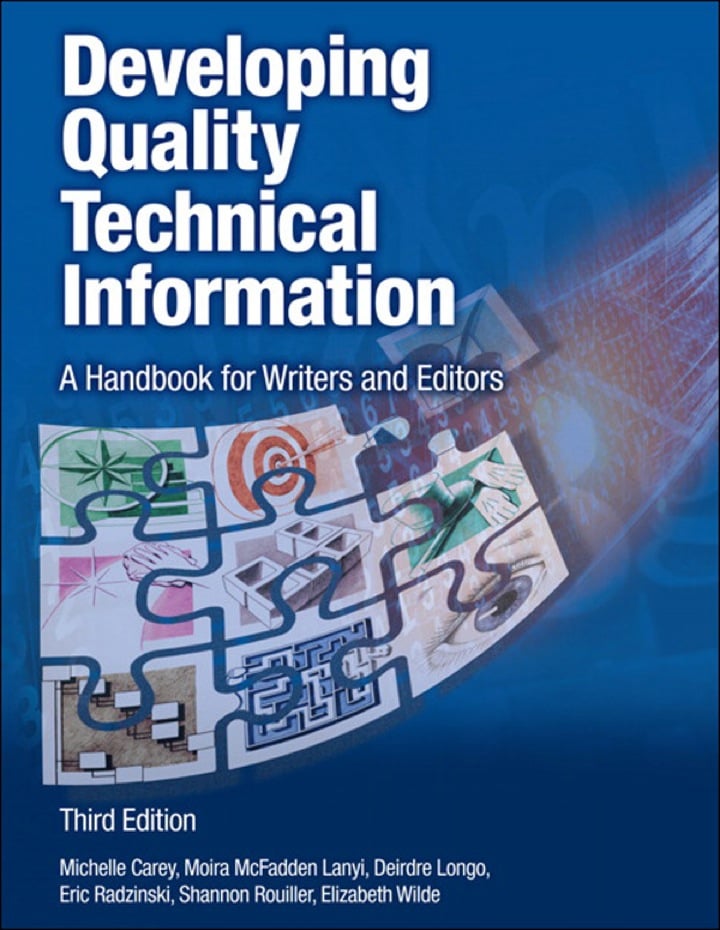
Developing Quality Technical Information: A Handbook for Writers and Editors, 3rd edition
PUBLISHER: PEARSON
eBook edition. 1 Year Subscription. Dành cho Cá nhân | Trường ĐH, Nhóm, Thư Viện: Gọi 0915920514 để báo giá Pearson, Vital Source eBook hoặc mua Sách In
Dựa trên kinh nghiệm truyền thông kỹ thuật vượt trội của IBM, người đọc khám phá các phương pháp hay nhất hiện nay để đáp ứng chín đặc điểm chất lượng: độ chính xác, rõ ràng, đầy đủ, cụ thể, tổ chức, khả năng truy xuất, phong cách, định hướng nhiệm vụ và hiệu quả trực quan. Được đóng gói với các hướng dẫn, danh sách kiểm tra và các ví dụ trước và sau, Phát triển thông tin kỹ thuật chất lượng, Phiên bản thứ ba là nguồn tài nguyên không thể thiếu cho tương lai của truyền thông kỹ thuật.
- Preface xviiAcknowledgments xixAbout the authors xxiiiPart 1. Introduction 1
- Chapter 1. Technical information continues to evolve 3Embedded assistance 4Progressive disclosure of information 9The technical writer’s role today 11Redefining quality technical information 13
- Chapter 2. Developing quality technical information 15Preparing to write: understanding users, goals, and product tasks 16Writing and rewriting 17Reviewing, testing, and evaluating technical information 19Part 2. Easy to use 21
- Chapter 3. Task orientation 23Write for the intended audience 25Present information from the users’ point of view 27Focus on users’ goals 32Identify tasks that support users’ goals 33Write user-oriented task topics, not function-oriented task topics 35Avoid an unnecessary focus on product features 41Indicate a practical reason for information 46Provide clear, step-by-step instructions 49Make each step a clear action for users to take 51Group steps for usability 53Clearly identify steps that are optional or conditional 58Task orientation checklist 64
- Chapter 4. Accuracy 67Research before you write 69Verify information that you write 74Maintain information currency 79Keep up with technical changes 79Avoid writing information that will become outdated 82Maintain consistency in all information about a subject 86Reuse information when possible 86Avoid introducing inconsistencies 88Use tools that automate checking for accuracy 93Accuracy checklist 96
- Chapter 5. Completeness 99Make user interfaces self-documenting 101Apply a pattern for disclosing information 107Cover all subjects that support users’ goals and only those subjects 115Create an outline or topic model 115Include only information based on user goals 118Make sure concepts and reference topics support the goals 122Cover each subject in only as much detail as users need 123Provide appropriate detail for your users and their experience level 123Include enough information 130Include only necessary information 136Repeat information only when users will benefit from it 141Completeness checklist 148Part 3. Easy to understand 151
- Chapter 6. Clarity 153Focus on the meaning 155Eliminate wordiness 161Write coherently 174Avoid ambiguity 180Use words as only one part of speech 180Avoid empty words 183Use words with a clear meaning 187Write positively 189Make the syntax of sentences clear 194Use pronouns correctly 199Place modifiers appropriately 201Use technical terms consistently and appropriately 205Decide whether to use a term 205Use terms consistently 207Define each term that is new to the intended audience 210Clarity checklist 212
- Chapter 7. Concreteness 215Consider the skill level and needs of users 220Use concreteness elements that are appropriate for the information type 223Use focused, realistic, and up-to-date concreteness elements 240Use scenarios to illustrate tasks and to provide overviews 243Make code examples and samples easy to use 247Set the context for examples and scenarios 251Use similes and analogies to relate unfamiliar information to familiar information 253Use specific language 256Concreteness checklist 259
- Chapter 8. Style 261Use active and passive voice appropriately 263Convey the right tone 267Avoid gender and cultural bias 273Spell terms consistently and correctly 276Use proper capitalization 280Use consistent and correct punctuation 284Apply consistent highlighting 296Make elements parallel 302Apply templates and reuse commonly used expressions 305Use consistent markup tagging 311Style checklist 314Part 4. Easy to find 317
- Chapter 9. Organization 319Put information where users expect it 322Separate contextual information from other types of information 324Separate contextual information into the appropriate type of embedded assistance 332Separate noncontextual information into discrete topics by type 337Arrange elements to facilitate navigation 345Organize elements sequentially 350Organize elements consistently 354Reveal how elements fit together 360Emphasize main points; subordinate secondary points 366Organization checklist 376
- Chapter 10. Retrievability 379Optimize for searching and browsing 381Use clear, descriptive titles 381Use keywords effectively 384Optimize the table of contents for scanning 389Guide users through the information 394Link appropriately 399Link to essential information 400Avoid redundant links 405Use effective wording for links 409Provide helpful entry points 413Retrievability checklist 420
- Chapter 11. Visual effectiveness 421Apply visual design practices to textual elements 424Use graphics that are meaningful and appropriate 431Illustrate significant tasks and concepts 431Make information interactive 441Use screen captures judiciously 448Apply a consistent visual style 460Use visual elements to help users find what they need 467Ensure that visual elements are accessible to all users 478Visual effectiveness checklist 483Part 5. Putting it all together 485
- Chapter 12. Applying more than one quality characteristic 487Applying quality characteristics to progressively disclosed information 488Applying quality characteristics to information for an international audience 494Applying quality characteristics to topic-based information 501
- Chapter 13. Reviewing, testing, and evaluating technical information 515Reviewing technical information 516Testing information for usability 518Testing technical information 524Editing and evaluating technical information 527Reading and editing the information 531Reviewing the visual elements 536Part 6. Appendixes 543Appendix A. Quality checklist 545Appendix B. Who checks which characteristics? 549Glossary 555Resources and references 565Index 573















